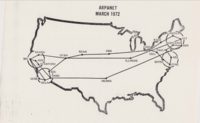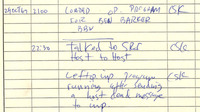ARPANET launches the world's first packet-switched wide area computer network
|
29th October 1969 At 10:30 pm on October 29th 1969, two computers connected and launched the world's first packet-switched wide area computer network: the ARPANET. The first message on the ARPANET was sent by UCLA student programmer Charles S Kline. The message was intended to be a login request to the Stanford Research Institute’s SDS 940 host computer. The message was meant to be the single word “login,” but only the letters "l" and "o" were transmitted before the system crashed. An hour later, the full “login” message was successfully sent as the second transmission. The U.S. Department of Defense Advanced Research Projects Agency (DARPA, then known as ARPA) began the work that led to ARPANET in the mid 1960s. Their goal was to create a computer network to provide reliable communications, even if the network was attacked. The initial ARPANET was a network of just four computers at four different sites:
The networking technology pioneered in the ARPANET went on to become the foundations of the Internet and the World Wide Web. Related information: Image:
Related Items in the Collection:
|
Click on the Images For Detail
|























